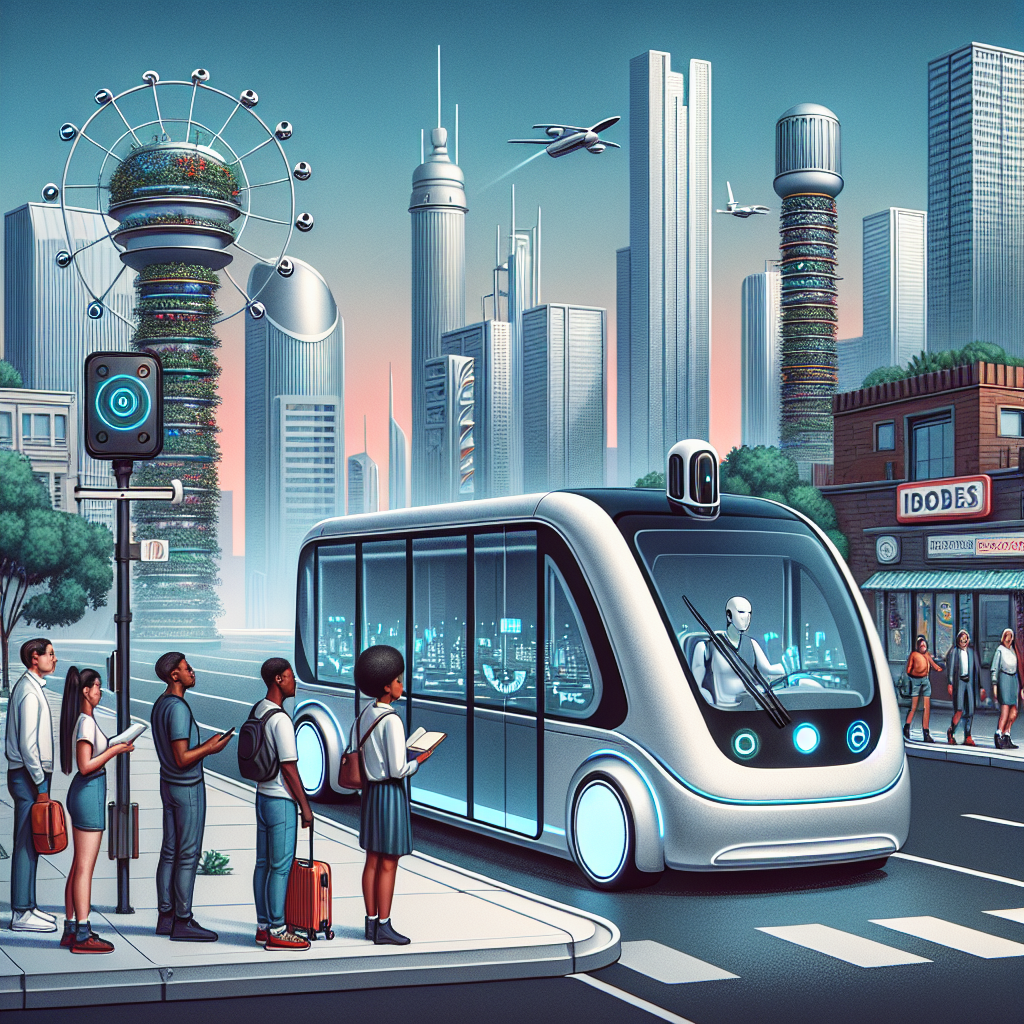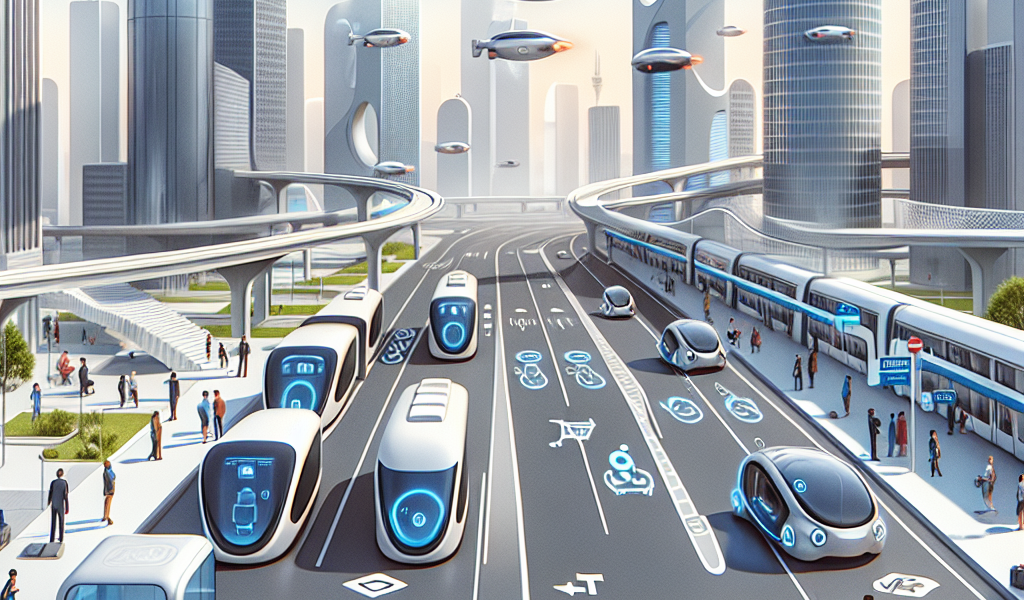-
Table of Contents
“Seamlessly Connecting Tomorrow: The Future of Autonomous Public Transportation”
Introduction

The Future of Autonomous Public Transportation
The advent of autonomous public transportation heralds a transformative era in urban mobility, promising to revolutionize the way people commute. As cities grapple with increasing congestion, pollution, and the demand for efficient transit solutions, autonomous vehicles (AVs) emerge as a beacon of innovation. These self-driving buses, shuttles, and trains are poised to enhance safety, reduce operational costs, and provide seamless, on-demand services. By leveraging advanced technologies such as artificial intelligence, machine learning, and the Internet of Things (IoT), autonomous public transportation systems aim to create a more sustainable, accessible, and efficient urban environment. This paradigm shift not only envisions a future where human error is minimized but also paves the way for smart cities, where integrated, intelligent transport networks cater to the dynamic needs of the populace.
Integration Of Autonomous Vehicles In Urban Public Transit Systems
The future of urban public transportation is on the brink of a revolutionary transformation, driven by the integration of autonomous vehicles. As cities around the world grapple with increasing congestion, pollution, and the need for more efficient transit solutions, autonomous vehicles present a promising alternative. These self-driving marvels are not just a futuristic concept but are steadily becoming a reality, with significant implications for urban mobility.
One of the most compelling advantages of autonomous vehicles in public transit systems is their potential to reduce traffic congestion. By communicating with each other and with traffic management systems, these vehicles can optimize routes, avoid bottlenecks, and maintain smooth traffic flow. This level of coordination is beyond the capabilities of human drivers and could lead to a significant reduction in traffic jams, making commutes faster and more predictable.
Moreover, autonomous vehicles promise to enhance the safety of urban transportation. Human error is a leading cause of traffic accidents, and by removing the human element, autonomous vehicles can drastically reduce the number of collisions. Equipped with advanced sensors and algorithms, these vehicles can detect and respond to potential hazards more quickly and accurately than a human driver ever could. This not only protects passengers but also pedestrians and cyclists, contributing to a safer urban environment.
In addition to safety and efficiency, the integration of autonomous vehicles into public transit systems can also address environmental concerns. Electric autonomous vehicles, in particular, offer a cleaner alternative to traditional gasoline-powered buses and taxis. By reducing emissions, these vehicles can help cities meet their environmental goals and improve air quality for residents. Furthermore, the ability to operate continuously without the need for breaks means that fewer vehicles are required to provide the same level of service, further reducing the environmental footprint.
The convenience factor cannot be overlooked either. Autonomous vehicles can provide on-demand services, allowing passengers to summon a ride at any time, much like current ride-sharing apps but without the need for a human driver. This flexibility can make public transit more appealing, especially in areas where traditional services are infrequent or unavailable. Additionally, autonomous shuttles can be designed to accommodate various needs, from wheelchair accessibility to space for bicycles, making them a versatile option for a diverse urban population.
However, the transition to autonomous public transportation is not without its challenges. One significant hurdle is the need for substantial infrastructure upgrades. Cities will need to invest in smart traffic signals, dedicated lanes, and other technologies to support the seamless operation of autonomous vehicles. Moreover, there are regulatory and legal considerations to address, including liability issues in the event of an accident and the development of standards for vehicle safety and performance.
Public acceptance is another critical factor. While the technology behind autonomous vehicles is advancing rapidly, gaining the trust of the public is essential for widespread adoption. Education and transparent communication about the benefits and safety of autonomous vehicles will be crucial in overcoming skepticism and resistance.
Despite these challenges, the potential benefits of integrating autonomous vehicles into urban public transit systems are too significant to ignore. As technology continues to evolve and cities adapt to new transportation paradigms, autonomous vehicles are poised to play a central role in shaping the future of urban mobility. By reducing congestion, enhancing safety, and offering environmentally friendly and convenient transportation options, these vehicles can transform the way we navigate our cities, making them more livable and sustainable for everyone.
The Role Of AI In Enhancing Safety And Efficiency In Autonomous Public Transportation
As cities around the world grapple with increasing congestion and pollution, the promise of autonomous public transportation offers a beacon of hope. Central to this transformative shift is the role of artificial intelligence (AI) in enhancing both safety and efficiency. The integration of AI into autonomous vehicles is not just a technological advancement; it represents a fundamental change in how we envision urban mobility.
To begin with, AI’s ability to process vast amounts of data in real-time is crucial for the safe operation of autonomous public transportation. These systems rely on a network of sensors, cameras, and radar to navigate complex urban environments. AI algorithms analyze this data to make split-second decisions, such as identifying pedestrians, cyclists, and other vehicles. This rapid processing capability significantly reduces the likelihood of human error, which is a leading cause of accidents in traditional transportation systems.
Moreover, AI enhances safety through predictive analytics. By continuously learning from historical data and real-time inputs, AI can anticipate potential hazards before they become imminent threats. For instance, if an autonomous bus detects erratic behavior from a nearby vehicle, it can adjust its speed or change lanes to avoid a collision. This proactive approach to safety is a game-changer, offering a level of foresight that human drivers simply cannot match.
In addition to safety, AI plays a pivotal role in improving the efficiency of autonomous public transportation. One of the most significant benefits is the optimization of routes. AI can analyze traffic patterns, weather conditions, and passenger demand to determine the most efficient routes in real-time. This dynamic routing not only reduces travel time but also minimizes fuel consumption and emissions, contributing to a more sustainable urban environment.
Furthermore, AI facilitates seamless coordination between multiple autonomous vehicles. In a traditional public transportation system, buses and trains often operate independently, leading to inefficiencies such as overcrowding or underutilization. AI can synchronize the movements of an entire fleet, ensuring that vehicles are deployed where they are needed most. This level of coordination can significantly enhance the overall capacity and reliability of public transportation networks.
Another critical aspect of AI in autonomous public transportation is its ability to provide personalized experiences for passengers. By analyzing data such as travel history and preferences, AI can offer tailored recommendations and services. For example, an autonomous bus might suggest the best transfer points or provide real-time updates on delays. This personalized approach not only improves the passenger experience but also encourages more people to use public transportation, thereby reducing the number of private vehicles on the road.
Despite these promising advancements, the widespread adoption of AI-driven autonomous public transportation is not without challenges. Regulatory frameworks need to be established to ensure the safe and ethical deployment of these technologies. Public acceptance is also a significant hurdle, as many people remain skeptical about the safety and reliability of autonomous vehicles. However, as AI continues to demonstrate its capabilities and benefits, it is likely that these concerns will diminish over time.
In conclusion, the role of AI in enhancing safety and efficiency in autonomous public transportation cannot be overstated. From real-time data processing and predictive analytics to route optimization and personalized passenger experiences, AI is at the heart of this transportation revolution. As cities continue to evolve and adapt to new technologies, the integration of AI into autonomous public transportation systems promises a future where urban mobility is safer, more efficient, and more sustainable.
Environmental Impact And Sustainability Of Autonomous Public Transit Solutions
The future of autonomous public transportation holds significant promise for addressing some of the most pressing environmental challenges of our time. As cities around the world grapple with increasing pollution levels and the urgent need to reduce carbon emissions, autonomous public transit solutions are emerging as a viable and sustainable alternative. These innovative systems not only aim to revolutionize the way we commute but also offer substantial environmental benefits that could help mitigate the adverse effects of climate change.
One of the primary environmental advantages of autonomous public transportation is its potential to reduce greenhouse gas emissions. Traditional public transit systems, such as buses and trains, often rely on fossil fuels, contributing to air pollution and global warming. In contrast, many autonomous vehicles are designed to be electric, leveraging renewable energy sources like solar and wind power. By transitioning to electric autonomous fleets, cities can significantly cut down on their carbon footprint, leading to cleaner air and a healthier environment for residents.
Moreover, autonomous public transit solutions can enhance energy efficiency. Human drivers, despite their best efforts, are prone to inefficiencies such as idling, abrupt acceleration, and inconsistent speeds, all of which contribute to higher fuel consumption. Autonomous vehicles, equipped with advanced algorithms and sensors, can optimize routes, maintain steady speeds, and reduce unnecessary stops, thereby conserving energy. This increased efficiency not only lowers operational costs but also minimizes the environmental impact of public transportation.
In addition to reducing emissions and improving energy efficiency, autonomous public transit systems can also alleviate traffic congestion, a major source of urban pollution. Traffic jams result in prolonged idling and stop-and-go driving, which significantly increase fuel consumption and emissions. Autonomous vehicles, through real-time data analysis and communication with other vehicles and infrastructure, can navigate more efficiently and avoid congested routes. This capability not only shortens travel times but also reduces the overall number of vehicles on the road, further decreasing pollution levels.
Furthermore, the implementation of autonomous public transportation can lead to more sustainable urban planning. With the advent of self-driving buses and shuttles, cities can rethink their infrastructure, prioritizing pedestrian-friendly spaces and green areas over extensive road networks. This shift can promote a more sustainable and livable urban environment, encouraging residents to rely less on private cars and more on shared, eco-friendly transit options.
However, the transition to autonomous public transportation is not without its challenges. Ensuring the sustainability of these systems requires careful consideration of the entire lifecycle of autonomous vehicles, from production to disposal. The manufacturing of electric vehicles, for instance, involves the extraction of rare earth metals, which can have significant environmental impacts. Therefore, it is crucial to develop recycling and reuse strategies for these materials to minimize their ecological footprint.
Moreover, the widespread adoption of autonomous public transit solutions necessitates substantial investments in infrastructure and technology. Governments and private stakeholders must collaborate to build the necessary charging stations, communication networks, and regulatory frameworks to support the seamless integration of autonomous vehicles into existing transit systems. Public awareness and acceptance are also vital, as the success of these initiatives depends on the willingness of individuals to embrace new modes of transportation.
In conclusion, the environmental impact and sustainability of autonomous public transit solutions present a compelling case for their adoption. By reducing emissions, enhancing energy efficiency, alleviating traffic congestion, and promoting sustainable urban planning, these systems offer a promising path toward a greener future. While challenges remain, the potential benefits of autonomous public transportation make it a critical component of the global effort to combat climate change and create more sustainable cities.
Conclusion
The future of autonomous public transportation holds significant promise for enhancing urban mobility, reducing traffic congestion, and lowering environmental impact. With advancements in artificial intelligence, sensor technology, and connectivity, autonomous vehicles are expected to offer safer, more efficient, and more reliable transit options. These systems can operate continuously, optimize routes in real-time, and integrate seamlessly with other modes of transportation, creating a more cohesive and accessible public transit network. However, challenges such as regulatory hurdles, cybersecurity concerns, and public acceptance must be addressed to fully realize the potential of autonomous public transportation. Overall, the integration of autonomous technology into public transit systems is poised to revolutionize the way people move within cities, contributing to smarter, more sustainable urban environments.





